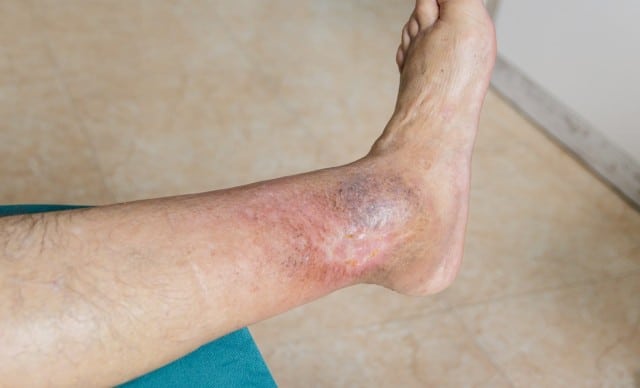
Chronic venous wounds—also known as venous leg ulcers—are not just slow to heal; they’re also highly susceptible to infections. In Honolulu’s warm and humid climate, the risk of bacterial growth increases, making proper wound care more important than ever. At Vein & Skin Center of Hawaii, we blend clinical best practices—like endovenous ablation, wound cleaning, debridement, compression therapy, dressings, and lifestyle guidance—to reduce infection risk and support healthy healing.
If you’re managing venous wounds, you don’t have to do it alone. With the right care, expert support, and compassionate treatment tailored for island living, you can heal better, faster, and safer.
Understanding the Infection Risks in Venous Wounds
Venous leg ulcers arise when damaged vein valves cause blood to pool in the legs, leading to swelling, tissue breakdown, and painful sores that often persist for weeks or months. Because these wounds stay open, bacteria can easily colonize them. While colonization alone isn’t an infection, it’s a warning sign. A true infection is marked by increasing redness, pain, odor, purulent drainage, sometimes fever, indicating tissue invasion and delayed healing.
Untreated infections can escalate to cellulitis, severe pain, bone infection (osteomyelitis), or even amputation in severe cases. Preventing infection is therefore critical to recovery and quality of life.
Five Cornerstones of Infection-Free Wound Care
1. A randomized trial showed that early endovenous ablation of superficial venous reflux as an adjunct to compression therapy was associated with a shorter time to healing of venous leg ulcers than compression therapy alone.
2. Keep It Clean: Cleansing & Debridement
Effective wound care starts with cleaning. Use normal saline or tap water to irrigate the wound and remove debris—tools like bulbs or syringes can help flush properly. Tap water is as safe as saline, according to research.
After cleaning, debris and necrotic tissue should be removed via debridement—performed by your clinician—to support healing and reduce bacterial growth.
3. Compression Therapy: Circulation & Healing
Compression therapy is the gold standard for venous ulcers. It reduces swelling and venous pressure, key factors in preventing infection. Multi-layer elastic bandages or stockings (30–40 mmHg) promote healing and minimize recurrence.
Compression also enhances blood circulation, helping the immune system reach the wound bed to fight infections. Without compression, wounds remain moist and prone to bacterial growth.
4. Moisture Balance & Smart Dressings
Controlling moisture is vital: too much fluid leads to maceration; too little slows healing. Dressings like hydrogels, alginates, foams, or hydrocolloids maintain this balance under compression.
If infection risk is high, antimicrobial dressings—such as silver, iodine, or honey-infused—create an environment hostile to bacteria.
Dressings should be atraumatic, comfortable, and maintain integrity under compression.
5. Regular Monitoring
It’s crucial to check wounds weekly for infection signs: increased redness, swelling, pain, odor, greenish discharge, or fever. Infection means antibiotics—usually oral, for up to two weeks—combined with debridement and dressing adjustments.
Not all bacteria-inhabited wounds need antibiotics—only those with clinical infection signs. Overusing antibiotics can lead to resistance.
6. Supportive Lifestyle Measures
- Leg Elevation: Raise your legs above heart level for 30 minutes, 3–4 times daily, to lower swelling and support circulation.
- Gentle Exercise: Daily walking activates calf muscles and boosts blood flow.
- Skin Care: Clean, moisturize, and protect periwound skin to prevent breakdown.
- Nutrition & Hydration: Eat plenty of protein, iron, vitamins, and stay hydrated—excellent nutrition supports immunity and tissue regeneration.
- Risk Factor Management: Manage blood sugar, quit smoking, control weight, and treat varicose veins.
When Standard Care Isn’t Enough
If wounds don’t improve in 4–6 weeks despite optimal care, advanced therapies are warranted:
- Negative-Pressure Wound Therapy (NPWT): Applies vacuum to draw out fluid, reduce edema, and improve blood flow.
- Cellular/Tissue-Based Products: Grafts or bioactive dressings speed healing in stubborn cases.
- Skin Grafting: Considered for large or refractory ulcers.
- Surgical Correction: Treating underlying venous issues (like ablation or phlebectomy) helps prevent recurrence.
Why Our Honolulu Team Excels
At Vein & Skin Center of Hawaii, we’re committed to infection prevention in venous wounds by offering:
- Evidence-Based Protocols: We follow accepted standards—cleaning, debridement, compression, moisture balance, and antibiotics as needed.
- Tailored Dressings & Compression: We choose dressings approved for Honolulu’s humid climate to manage exudate and combat microbes.
- Meticulous Follow-Up: Frequent appointments ensure early detection of infection and timely treatment adjustments.
- Integrated Lifestyle Coaching: We coach on elevation, exercise, nutrition, and risk factor management.
- Access to Advanced Care: We offer NPWT, regenerative dressings, grafting, and coordinate vascular surgery when necessary.
Frequently Asked Questions (FAQ)
How often should I clean and dress the wound?
Clean and dress 1–3 times per week, or more frequently if drainage is heavy.
Can I use regular soap and water?
Yes—tap water is as effective as saline for cleansing. Avoid harsh agents like hydrogen peroxide or undiluted iodine—they can damage new tissue.
When should I wear compression?
Wear compression stockings or bandages daily, under and over dressings—higher compression (30–40 mmHg) often delivers better results.
How do I know if it’s infected?
Watch for increased pain, redness, warmth, swelling, foul odor, pus, or fever. Any of these signs warrants prompt medical review.
When are antibiotics needed?
Antibiotics are reserved for clinical infection and typically prescribed for up to 2 weeks.
My wound hasn’t healed in 6 weeks—what now?
Consider advanced therapies like NPWT, regenerative grafts, or referral for surgical vein correction.
